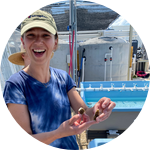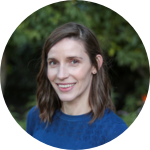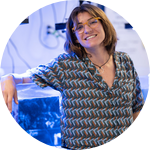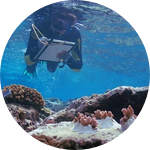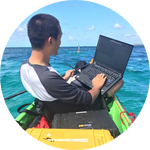About This Project
Changes in coral morphology underpin reef ecosystem services, yet high throughput, high resolution methods for non-invasively tracking coral growth in experiments are limited. We propose to fill this gap through the development of an open-source imaging platform for the creation of 3D models that allow us to capture fine-scale changes in coral morphology over time. With an imaging time of less than 1 min/sample, this technology will increase the speed and quality of morphometric data collection.
Ask the Scientists
Join The DiscussionWhat is the context of this research?
Stony corals are the foundation of reef ecosystems–they build the physical 3D habitats and landscapes vital to functional coral reefs. Rapid environmental change threatens coral, and corals show evidence of morphological techniques that may be essential to survival. Increasing our understanding of changes to coral growth is necessary for informing restoration and conservation under climate change. Photogrammetry is a widely used technology to noninvasively monitor corals, and high resolution 3D renderings unlock time series tracking of changes in branch length, volume, and surface area. This technology is essential for answering urgent questions of coral performance, and the proposed open source station will bring accurate and efficient 3D modeling to any researcher.
What is the significance of this project?
This platform will be tailored specifically to imaging coral fragments, resolving associated difficulties including consistency in 3D model quality, reproducibility, error in key morphological metrics (like surface area and volume), and stress to corals over long imaging periods. While select research groups have made improvements for personal imaging methods, there is currently no open-source or standardized method. The generation of this platform would advance the entire field of coral growth and morphological studies by making high resolution, repeatable 3D models accessible to all. While designed for use with live coral, this tool will also generate models of high enough quality for coral skeletal studies, which often exacerbate inaccuracies from poor lighting conditions.
What are the goals of the project?
The goal of this project is to develop an efficient, high resolution imaging station that any laboratory can build and install. An existing imaging station at HIMB is an excellent start, but this imaging station is highly specific to the lab where it is used and has only been applied to Pacific coral. This collaboration between the Cnidarian Evolutionary Ecology Lab at USC and Coral Resilience Lab at HIMB will bring this imaging station to the next level, simplifying materials requirements, control code, build requirements, and be accompanied by a detailed installation guide and methods paper for a fully transferable model. The novel build will be validated through a growth experiment on Caribbean acroporids that requires quick and accurate tracking of branch emergence in fall 2025.
Budget
The budget will cover the materials essential for the construction and development of the imaging station, including a high quality camera array and supporting electronics, lighting, a photography turntable, and structural material. The Coral Resilience Lab (CRL) at HIMB has developed previous prototypes. We propose to streamline the design, simplify assembly, and create a general use instruction and operation manual, ultimately generating a platform accessible to all. The budget will also cover a one week trip (for Maya) from Los Angeles to CRL to share and learn the details of a prototype, followed by focused development time and the initial construction of the updated version of the imaging station. The constructed imaging station will then be brought to USC for trial and refinement. The final build will be fully documented and accompanied by an open source methods paper to make the approach broadly accessible.
Endorsed by
 Project Timeline
Project Timeline
Researchers will meet via Zoom in late 2024 to generate construction plans that streamline imaging station build requirements and transferability. Construction will begin in early 2025 when the USC team visits the collaborating research group at HIMB. The build will be completed by summer 2025 in anticipation of an experiment at USC that will track the emergence of new coral branches using time series 3D models. A methods paper will accompany this technology, with a goal submission of fall 2025.
Nov 11, 2024
Project Launched
Dec 01, 2024
Begin design optimization process
Apr 01, 2025
Travel to Hawaii for design build
Jun 01, 2025
Finalize imaging station
Jul 01, 2025
Utilize instrument to track coral branch emergence in an experiment at USC
Meet the Team
Affiliates
Affiliates
Affiliates
Team Bio
The Cnidarian Evolutionary Ecology (CEE) lab at USC is teaming up with the Coral Resilience Lab (CRL) at HIMB for this coral tech! The CRL studies the drivers and consequences of variation and develops innovative instrumentation to improve coral research, while the CEE lab investigates the ways that an organism’s physical traits are produced and modified by genetic and environmental effects. Both labs value the transformation of scientific findings into tools for conservation and management.
Maya Gomez
Maya Gomez is a 3rd year PhD student and NSF GRFP fellow in Dr. Carly Kenkel’s Cnidarian Evolutionary Ecology Lab at the University of Southern California. Her dissertation focuses on the morphological plasticity of reef-building corals–the ability for corals to change their growth formations in response to changes in the environment. She has extensive experience with photogrammetry, and has developed a high throughput, fully automated photogrammetry processing pipeline that utilizes custom scripts to remotely process hundreds of Metashape 3D models using USC’s high performance computing system. Her work has resulted in reduced generation time for higher quality models, as well as expedited downstream phenotyping through the integration of custom scale bars during the imaging and model building processes.
The integration of photogrammetry technology and molecular approaches is foundational to Maya’s research, as she takes a multi-scale approach to decipher the mechanisms underpinning morphological plasticity at colony, polyp, and cellular-levels. By building connections between these scales of organization and the underlying mechanisms, she aims to link small-scale patterns of plasticity with the large-scale processes providing valuable ecosystem services. Her work not only informs our understanding of biological function and organization but can also be directly applied to reef restoration through a greater understanding of genotype and environment-based growth and performance. She regularly applies her work to reefs throughout the Caribbean as part of the Perry Institute for Marine Science, who she remains affiliated with.
Maya has presented her work at multiple conferences, including as an invited speaker for the Feel the Flow: How Water Movement Shapes Organisms and Ecosystems symposium at the Society for Integrative and Comparative Biology conference in early 2024. Maya graduated from Middlebury College in 2020 with a B.A. in Biology and Spanish.
Carlo Caruso
Carlo is a founding member of the Coral Resilience Lab researching coral thermal tolerance with an emphasis on restoration applications and leads a group developing innovative instrumentation and exploring new technologies to improve experimental design and data collection for coral research.
Stanley Lio
Stanley is an Embedded Systems Engineer in the Oceanography department at the University of Hawaii at Manoa. He designs low-power custom electronics for research projects in the fields of physical oceanography and coral biology research.
Crawford Drury
Ford is a researcher in the Coral Resilience Lab studying thermal tolerance in reef-building corals.
Additional Information
As ocean conditions become increasingly variable, the viability of in situ coral experiments is at risk. From personal experience, the 2023 Caribbean thermal stress event resulted in the collapse of two long term (>1 yr) experiments that my lab was involved in, amounting to ~90% mortality of experiment outplants. The environmental risk associated with in situ experiments has resulted in an increase in the frequency of tank based experiments, leading to further demand for the optimization of land-based imaging protocols.
Project Backers
- 6Backers
- 103%Funded
- $7,256Total Donations
- $1,209.33Average Donation
